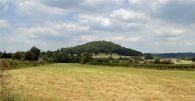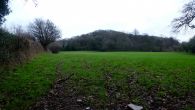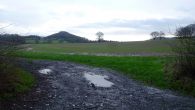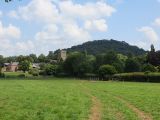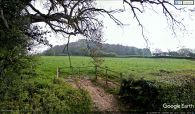Robin Hood's Butts (Canon Pyon) (1): Difference between revisions
mNo edit summary |
mNo edit summary |
||
| Line 4: | Line 4: | ||
[[File:{{#var:Pnimage}}|thumb|right|500px|Pyon Hill, the easternmost of the Robin Hood's Butts in Canon Pyon / [https://www.geograph.org.uk/photo/2492681 Philip Pankhurst, 4 Jul. 2011, Creative Commons.]]] | [[File:{{#var:Pnimage}}|thumb|right|500px|Pyon Hill, the easternmost of the Robin Hood's Butts in Canon Pyon / [https://www.geograph.org.uk/photo/2492681 Philip Pankhurst, 4 Jul. 2011, Creative Commons.]]] | ||
<p id="byline">By Henrik Thiil Nielsen, 2018-02-12. Revised by {{#realname:{{REVISIONUSER}}}}, {{REVISIONYEAR}}-{{REVISIONMONTH}}-{{REVISIONDAY2}}.</p><div class="no-img"> | <p id="byline">By Henrik Thiil Nielsen, 2018-02-12. Revised by {{#realname:{{REVISIONUSER}}}}, {{REVISIONYEAR}}-{{REVISIONMONTH}}-{{REVISIONDAY2}}.</p><div class="no-img"> | ||
'Robin Hood's Butts' is an alternative name of the Pyons, two conically shaped natural hills<ref>{{:Crawford, O G S 1924a}}; see p. 159.</ref> in Canon Pyon, Herefordshire. Pyon Hill, the larger and easternmost of the two, is located ''c.'' 150 m west of the A4110, while its smaller cousin, Butthouse Knap, is located ''c.'' 300 m WSW of Pyon Hill. They are situated ''c.'' 4.75 and ''c.'' 3.6 km southeast of Weobley and ''c.'' 10.5 km SSE of Pembridge. | 'Robin Hood's Butts' is an alternative name of the Pyons, two conically shaped natural hills<ref>{{:Crawford, O G S 1924a}}; see p. 159.</ref> in Canon Pyon, Herefordshire. Pyon Hill, the larger and easternmost of the two, is located ''c.'' 150 m west of the A4110, while its smaller cousin, Butthouse Knap, is located ''c.'' 300 m WSW of Pyon Hill. They are situated ''c.'' 4.75 and ''c.'' 3.6 km southeast of Weobley and ''c.'' 10.5 km SSE of Pembridge. The name 'Robin Hood's Butts' is first recorded in 1802. | ||
George Lipscomb in his ''Journey into South Wales'' (1802 Allusion below) notes that "Robin Hood's Butts, a little detached eminence, stands in the midst of a beautiful plain, called Pembridge bottom". In view of the plural form, it is surprising that he apparently took "Robin Hood's Butts" to refer to a single "eminence", and if "Pembridge bottom" ever had any currency as a place-name, it must be said that it has left no trace on any of the maps of the area that I have consulted (including those listed in the Maps section below), neither does it occur as a field name.<ref>[https://htt.herefordshire.gov.uk/her-search/field-names-and-landowners/search/results?name=pembridge&number=&parish=&owner=&SubmitButton=Search Herefordshire Through Time: Field name and landowners results: Pembridge.]</ref> When I asked Google Earth to take me to "Pembridge Bottom, Herefordshire" it decided I meant "Lower Bearwood" (i.e. Lower Barewood), ''c.'' 1 km south of Pembridge. I am not sure if this is significant; it may simply reflect the proximity of Lower Barewood to Pembridge and the similarity in sense of "Lower" to "Bottom". I have seen no other evidence for hills named Robin Hood's Butts in that neighbourhood or indeed anywhere in Herefordshire except in Canon Pyon. I believe Lipscomb intended to refer to one (or just possibly both) of the latter. The promontory Lady Lift which he mentions is in Yazor, ''c.'' 4.2 km WSW of Butthouse Knap, the westernmost of the Pyons. There is no Pembridge Bottom in Canon Pyon or neighbouring villages, but Lipscomb would not be the first travel writer to have lost his bearings. The concise entry in the 1824 edition of ''Patersons' Roads'' is more well-informed: "[In] West Hope. The conical hills called Robin Hood's Butts; and about 1 m. beyond Hide Field",<ref>{{:Paterson, Daniel | George Lipscomb in his ''Journey into South Wales'' (1802 Allusion below) notes that "Robin Hood's Butts, a little detached eminence, stands in the midst of a beautiful plain, called Pembridge bottom". In view of the plural form, it is surprising that he apparently took "Robin Hood's Butts" to refer to a single "eminence", and if "Pembridge bottom" ever had any currency as a place-name, it must be said that it has left no trace on any of the maps of the area that I have consulted (including those listed in the Maps section below), neither does it occur as a field name.<ref>[https://htt.herefordshire.gov.uk/her-search/field-names-and-landowners/search/results?name=pembridge&number=&parish=&owner=&SubmitButton=Search Herefordshire Through Time: Field name and landowners results: Pembridge.]</ref> When I asked Google Earth to take me to "Pembridge Bottom, Herefordshire" it decided I meant "Lower Bearwood" (i.e. Lower Barewood), ''c.'' 1 km south of Pembridge. I am not sure if this is significant; it may simply reflect the proximity of Lower Barewood to Pembridge and the similarity in sense of "Lower" to "Bottom". I have seen no other evidence for hills named Robin Hood's Butts in that neighbourhood or indeed anywhere in Herefordshire except in Canon Pyon. I believe Lipscomb intended to refer to one (or just possibly both) of the latter. The promontory Lady Lift which he mentions is in Yazor, ''c.'' 4.2 km WSW of Butthouse Knap, the westernmost of the Pyons. There is no Pembridge Bottom in Canon Pyon or neighbouring villages, but Lipscomb would not be the first travel writer to have lost his bearings. The concise entry in the 1824 edition of ''Patersons' Roads'' is more well-informed: "[In] West Hope. The conical hills called Robin Hood's Butts; and about 1 m. beyond Hide Field",<ref>{{:Paterson, Daniel 1822a}}, p. 142, ''s.n.'' West Hope.</ref> i.e. Hyde Field, ''c.'' 2.5 km north of the Pyons.{{#ask:[[Category:Records (Robin Hood's Butts, Canon Pyon (1))]]| format=embedded|embedformat=h4|columns=1|limit=1000|sort=Utitle|intro=<h3>Records</h3>}} | ||
{{#ask:[[Category:Allusions (Robin Hood's Butts, Canon Pyon (1))]]| format=embedded|embedformat=h4|columns=1|limit=1000|sort=Utitle|intro=<h3>Allusions</h3>}} | {{#ask:[[Category:Allusions (Robin Hood's Butts, Canon Pyon (1))]]| format=embedded|embedformat=h4|columns=1|limit=1000|sort=Utitle|intro=<h3>Allusions</h3>}} | ||
=== Gazetteers === | === Gazetteers === | ||
| Line 43: | Line 43: | ||
* [https://htt.herefordshire.gov.uk/her-search/field-names-and-landowners/search/results?name=pembridge&number=&parish=&owner=&SubmitButton=Search Herefordshire Through Time: Field name and landowners results: Pembridge] | * [https://htt.herefordshire.gov.uk/her-search/field-names-and-landowners/search/results?name=pembridge&number=&parish=&owner=&SubmitButton=Search Herefordshire Through Time: Field name and landowners results: Pembridge] | ||
* [https://en.wikipedia.org/wiki/Canon_Pyon Wikipedia: Canon Pyon.] | * [https://en.wikipedia.org/wiki/Canon_Pyon Wikipedia: Canon Pyon.] | ||
=== Brief mention === | |||
* {{:Paterson, Daniel 1822a}}, p. 142, ''s.n.'' West Hope. | |||
{{PnItemAlsoSee}} | {{PnItemAlsoSee}} | ||
Revision as of 14:26, 13 February 2018
[[File:|thumb|right|500px|Pyon Hill, the easternmost of the Robin Hood's Butts in Canon Pyon / Philip Pankhurst, 4 Jul. 2011, Creative Commons.]]
By Henrik Thiil Nielsen, 2018-02-12. Revised by Henrik Thiil Nielsen, 2018-02-13.
'Robin Hood's Butts' is an alternative name of the Pyons, two conically shaped natural hills[1] in Canon Pyon, Herefordshire. Pyon Hill, the larger and easternmost of the two, is located c. 150 m west of the A4110, while its smaller cousin, Butthouse Knap, is located c. 300 m WSW of Pyon Hill. They are situated c. 4.75 and c. 3.6 km southeast of Weobley and c. 10.5 km SSE of Pembridge. The name 'Robin Hood's Butts' is first recorded in 1802.
George Lipscomb in his Journey into South Wales (1802 Allusion below) notes that "Robin Hood's Butts, a little detached eminence, stands in the midst of a beautiful plain, called Pembridge bottom". In view of the plural form, it is surprising that he apparently took "Robin Hood's Butts" to refer to a single "eminence", and if "Pembridge bottom" ever had any currency as a place-name, it must be said that it has left no trace on any of the maps of the area that I have consulted (including those listed in the Maps section below), neither does it occur as a field name.[2] When I asked Google Earth to take me to "Pembridge Bottom, Herefordshire" it decided I meant "Lower Bearwood" (i.e. Lower Barewood), c. 1 km south of Pembridge. I am not sure if this is significant; it may simply reflect the proximity of Lower Barewood to Pembridge and the similarity in sense of "Lower" to "Bottom". I have seen no other evidence for hills named Robin Hood's Butts in that neighbourhood or indeed anywhere in Herefordshire except in Canon Pyon. I believe Lipscomb intended to refer to one (or just possibly both) of the latter. The promontory Lady Lift which he mentions is in Yazor, c. 4.2 km WSW of Butthouse Knap, the westernmost of the Pyons. There is no Pembridge Bottom in Canon Pyon or neighbouring villages, but Lipscomb would not be the first travel writer to have lost his bearings. The concise entry in the 1824 edition of Patersons' Roads is more well-informed: "[In] West Hope. The conical hills called Robin Hood's Butts; and about 1 m. beyond Hide Field",[3] i.e. Hyde Field, c. 2.5 km north of the Pyons.
Gazetteers
- Dobson, R. B., ed.; Taylor, J., ed. Rymes of Robyn Hood: an Introduction to the English Outlaw (London, 1976), p. 298, s.n. Robin Hoods' Butts.
Sources
- Crawford, O. G. S. 'Place-Names and Archaeology', chapter VIII in: Mawer, A.; Stenton, F.M. Introduction to the Survey of English Place-Names (English Place-Name Society, vol. I, pt. 1). (Cambridge, 1924), pp. 143-64; see p. 159
- Smith, A.H. English Place-Name Elements. Reprinted (English Place-Name Society, vols. XXV-XXVI) (Cambridge, 1970), pt. I, p. 165 s.n. butt2, b.
Maps
- 25" O.S. map Herefordshre XXVI.1 (1887; rev. 1886)
- 25" O.S. map Herefordshre XXVI.5 (1904; rev. 1902)
- 25" O.S. map Herefordshre XXVI.5 (1904; rev. 1902) (georeferenced)
- 6" O.S. map Herefordshire XXVI.NW 1886; surveyed 1886)
- 6" O.S. map Herefordshire XXVI.NW (1905; rev. 1902)
- 6" O.S. map Herefordshire XXVI.NW (1905; rev. 1902) (georeferenced)
- 6" O.S. map Herefordshire XXVI.NW (1952; rev. 1945)
- 1" O.S. map Hereford (Hills), Sheet 128 (1898; rev. 1897) (georeferenced)
- 1" O.S. map Hereford (Outline), Sheet 128 (1898; rev. 1897) (georeferenced)
- O.S. 1:25,000 SO44 (1956; surveyed 1945) (georeferenced)
- O.S. 1" Hereford (7th Ser.) (1960; surveyed 1944-60) (georeferenced)
- 1:1 million-1:10K O.S. SO 454495 (1900s) (georeferenced)
- 1:1m to 1:63K (1920s–1940s) SO439490 (georeferenced)
- Bartholomew 1/2" Hereford Sheet 23 (1902) (georeferenced)
- Bartholomew 1/2" Wye Valley Sheet 13 (1944) (georeferenced).
Discussion
- BBC: Domesday Reloaded: D-block GB-344000-249000: 1986, Folk Lore,Canon Pyon Area
- Leather, Ella Mary. 'Folk-Lore of the Shire', in: Reade, Compton, ed. Memorials of Old Herefordshire (London and Derby, 1904), pp. 148-66; see p. 163
- Leather, Ella Mary. The Folk-Lore of Herefordshire, collected from Oral and Printed Sources (Hereford; London, 1912), p. ?
- [Nicholson, George, ed.]. The Cambrian Traveller's Guide, in Every Direction; containing Remarks made during Many Excursions, in the Principality of Wales, and Bordering Districts, augmented by Extracts from the Best Writers. Second edition, corrected and considerably enlarged (Stourport and London, 1813), col. 1116. A slightly expanded paraphrase of the 1802 Allusion cited above
- Symonds, W.S. 'The Old Red Sandstone of Herefordshire', in: Moore, H. Cecil, compil. Transactions of the Woolhope Naturalists' Field Club. (Established 1851), 1852 to 1865 (Hereford, 1907), pp. 114-19; see p. 115
- Watkins, Alfred. The Old Straight Track: its Mounds, Beacons, Moats, Sites, and Mark Stones. 4th ed. (London, 1948), pp. 171, 178 (also editions of 1925, 1933, 1946, 1970, 1974, 1975, 1977, and 2014).
Background
Brief mention
Notes
- ↑ Crawford, O. G. S. 'Place-Names and Archaeology', chapter VIII in: Mawer, A.; Stenton, F.M. Introduction to the Survey of English Place-Names (English Place-Name Society, vol. I, pt. 1). (Cambridge, 1924), pp. 143-64; see p. 159.
- ↑ Herefordshire Through Time: Field name and landowners results: Pembridge.
- ↑ [Paterson, Daniel]; Mogg, Edward. Paterson's Roads; being an Entirely Original and Accurate Description of All the Direct and Principal Cross Roads in England and Wales, with Part of the Roads of Scotland, The Sixteenth Edition. To which are added Topographical Sketches of the Several Cities, Market Towns, and Remarkable Villages; and Descriptive Accounts of the Principal Seats of the Nobility and Gentry, the Antiquities, Natural Curiosities, and other Remarkable Objects throughout the Kingdom: the Whole remodelled, augmented, and improved, by the Addition of Numerous New Roads and New Admeasurements, and arranged upon a Plan at Once Novel, Clear, and Intelligible, is deduced from the Latest and Best Authorities, including a Table of Heights of Mountains from the Grand Trigonometrical Survey of the Kingdom, and an Entirely New Set of Maps (London, 1822), p. 142, s.n. West Hope.
Pyon Hill, the easternmost of the Robin Hood's Butts in Canon Pyon / Philip Pankhurst, 4 Jul. 2011, Creative Commons.
Pyon Hill / Jonathan Billinger, 8 Jan. 2016
Pyon Hill / Adam Buckley, 7 Aug. 2005
Pyon Hill / Jonathan Billinger, 8 Jan. 2016
Pyon Hill / Richard Webb, 1 Jul. 2014

